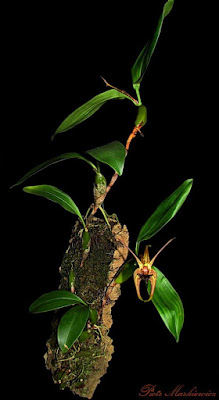Epigeneium amplum is found in China, India in Assam and Sikkim, the eastern Himalayas, Nepal, Bhutan, Myanmar, Thailand, and Vietnam. It grows epiphyte or lithophyte on mossy limestone rocks, in semi-deciduous and evergreen forests at elevations of 500-2100 metres.
Epigeneium amplum also called as The Large Epigeneium, Bulbophyllum amplum, Callista ampla, Callista coelogyne, Dendrobium coelogyne, Epigeneium annamense, Epigeneium coelogyne, Katherinea ampla, Katherinea coelogyne, Sarcopodium amplum, Sarcopodium annamense, Sarcopodium coelogyne, is a species of the genus Epigeneium. This species was described by Victor Samuel Summerhayes in 1957.
IDENTIFY EPIGENEIUM AMPLUM ORCHID PLANT
Epigeneium amplum is found in China, India in Assam and Sikkim, the eastern Himalayas, Nepal, Bhutan, Myanmar, Thailand, and Vietnam. It grows on mossy limestone rocks, in semi-deciduous and evergreen forests at elevations of 500-2100 meters.
It is a small sized, warm to cold growing epiphyte or lithophyte with very stout, obliquely ellipsoidal, sulcate pseudobulbs with 2 broadly elliptic-oblong, obtuse, notched at the apex, sessile or shortly petiolate leaves.
The Large Epigeneium blooms on an apical, short, racemose, 1 to few flowered inflorescence subtended by a basal bract, with powerfully fragrant, heavy textured, long-lasting flowers occuring in the fall and winter.
EPIGENEIUM AMPLUM ORCHID PLANT CARE AND CULTURE
Cultural information should only be used as a guide, and should be to be adapted to suit you. Your physical location; where you grow your plants, how much time you have to devote to their care, and many other factors, will need to be taken into account. Only then can you decide on the cultural methods that best suit you and your plants.
Light:
Epigeneium amplum like plenty of light, but cannot stand the full noonday rays of the sun (15000-40000 lux, filtered or diffused light is recommended.). These usually do best when placed so that they can get the early morning sun, but are shaded from about 10 a.m. onwards in the Summer time. In the Winter they can usually stand the sun's rays up to 11.30 a.m.
Temperature:
The average temperature of the summer day is 25-26 ° C, night 21 ° C, giving a daily difference of 4-6 ° C. In winter, the average day temperature is 27-30 ° C, night 16-17 ° C, giving a daily difference of 13 ° C.
Humidity:
The Large Epigeneium need the humidity of 80-90% throughout the growing period (i.e. from the time the first shoots of Spring show themselves until the last pseudobulb in Summer has grown to its maximum). In winter, the humidity drops to 65%.
Too dry air has a negative effect on the development of the plant: its growth is inhibited, and the leaves begin to turn yellow and dry out. The higher temperature, the higher the humidity should be, and the higher the humidity, the more often and longer it is necessary to ventilate the room where the plants are contained, otherwise the probability of rotting and various kinds of fungal diseases.
Substrate, growing media and repotting:
Epigeneium amplum grows best in wooden baskets with osmunda fibre as substrate (line the bottom with a few large pieces of wood-charcoal, which helps to provide aeration, and counteracts any tendency of the compost to ferment). The pseudobulbs can be tied, where necessary, to the hanging wires, thus ensuring stability.
This species can also be grown on rafts that are formed by nailing (with copper nails) a number of short lengths of beech or hardwood horizontally across a similar number of perpendicular pieces to form a sort of lattice or grating. The raft is covered with fibre or peat with a little green sphagnum moss, the orchid being fastened thereon with copper wire.
It does not need frequent repot, therefore, it is desirable to transplant only when it is really necessary, for example, in cases of strong salinization or compaction of the substrate, at its critically high or low pH (the norm is from 5.5 to 6.5) or when the plant grows very strongly and the pot becomes cramped to it (pseudobulbs begin to hang from the edges of the pot). Repotting is best done immediately after flowering when new roots and new growth begin to grow.
Watering:
Water must be literally poured on throughout the summer season right up to the time when the season's growths have reached full development; with the coming of autumn the quantity of water should be appreciably diminished, but this plant should not be allowed to dry out, and even in midwinter watering should be continued by giving the compost a good soaking once a fortnight-choosing a bright, clear morning for the purpose.
Watering is directly dependent on the temperature of the content, the higher it is, the more often it needs to be watered. When watering, excess water should flow freely from the pot, since stagnation of water both inside the pot and in its pan can very quickly lead to rotting of the roots and the lower part of the plant.
Fertilizer:
It is recommended to use a 1/4-1/2 dose of orchid fertilizer weekly. You can use the balanced fertilizer throughout the year or from spring to mid-summer use high-nitrogen fertilizer, and then until the end of autumn high-phosphoric fertilizer to stimulate flowering.
Rest period:
Epigeneium amplum need less water in the winter, especially if they grow under the conditions of a dark, short day that occurs at moderate latitudes. They should dry somewhat between waterings, but they should not be dry for a longer period. Frequent morning fogging and rare, economical watering should allow the plant to go through a dry period of rest, while providing it with sufficient humidity. Fertilization should be reduced or eliminated until new growths appear and a more abundant spring watering begins.















COMMENTS